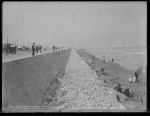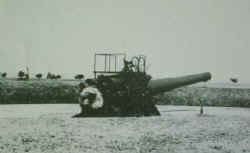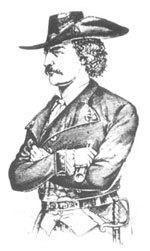![]()
 For
a few weeks we lived in Galveston, Texas. We enrolled in school. Marvin
was placed in an all Spanish speaking class because he did not talk much and the
administrators believed he did not speak English. They then thought he was
a little slow as he did not understand Spanish either. Father straightened
it out in a couple of days.
For
a few weeks we lived in Galveston, Texas. We enrolled in school. Marvin
was placed in an all Spanish speaking class because he did not talk much and the
administrators believed he did not speak English. They then thought he was
a little slow as he did not understand Spanish either. Father straightened
it out in a couple of days.
Mother continued to sketch and
I explored the sea wall and piers that extending out into the water to breakup
the rush of the sea.
 There
were large shore to ship gun battery's along the coast. There was also a
smell about the place: as if sea weed had almost dried.
There
were large shore to ship gun battery's along the coast. There was also a
smell about the place: as if sea weed had almost dried.
One memorable night our Father came home late. He had won lots of money at poker and had money in every pocket of his clothes. Mother spent a couple of hours 'ironing' the money as it was all crinkled. It was hard living as the facilities were awful and Father made arrangement to return to Fort Sam Huston in San Antonio.

|
Galveston Island has been occupied since the early 1500's, serving as a home to Akokisa Indians (once thought to be the Karankawa Indians), the infamous pirate Jean Lafitte, "little Ellis Island," "the Wall Street of the Southwest," the richest city in Texas and the site of the worst natural disaster in U.S. history. |
|
Galveston was named for Bernardo de Galvez, a Spanish colonial governor and general. Galvez sent Jose de Evia to chart the Gulf of Mexico from the Texas Coast to New Orleans, and on July 23, 1786 de Evia charted an area near the mouth of a river and named it Galveston Bay. Later the island and city took the same name. Bernardo de Galvez died the same year, never setting foot on his namesake. In the 1500's, Galveston Island was home to Karankawa Indians who camped, fished and hunted the swampy land and buried their dead here. The Spanish explorer Cabeza de Vaca was stranded on the Island living among the Karankawa for several years as a medicine man and slave. In the late 1600's French explorer Robert Cavelier La Salle, although he did not reach Galveston Island, claimed this area for King Louis and named it St. Louis. |
|
General James Long attempted to recruit Lafitte to help make Texas independent from Spain and Mexico but Lafitte remained neutral. In 1820 Mexico won independence from Spain, but Lafitte stayed on the Island. After Lafitte's attack on an American ship, he was forced to abandon his operations here in May 1821. Before leaving, he held a huge party for his pirates with wine and whiskey and burned his settlement. It is believed that he had buried treasure on the Island, but it has never been found. In 1821, Jane Long, while waiting for the return of her husband General James Long, became "The Mother of Texas" giving birth to the first Anglo-Saxon native Texan, Mary Jane Long on Bolivar Peninsula. Gen. Long had been killed in Mexico. In 1836, four ships of the Texas Navy made headquarters on the Island and protected the Texas coast from harassment by the Mexican Navy. These ships prevented supplies and men from reaching Santa Anna, insuring victory for Sam Houston's army at San Jacinto, 22 miles northwest of Galveston. |
|
In 1836, Michel B. Menard, a native of Canada, purchased a "league and labor" of land for $50,000 from the Austin Colony to establish the City of Galveston. The City of Galveston started with an area of seven square miles. enard, needed additional money to promote the town and formed the City of Galveston with nine other men. These men were Gail Borden, Jr. (publisher of the Telegraph and Texas Register and inventor of condensed milk); Samuel May Williams (former secretary to Stephen F. Austin and successful merchant); Thomas F. McKinney (Williams' mercantile partner and an early cotton trader); William H. Jack (Texas patriot and distinguished statesman); A.J. Yates (loan commissioner for the Republic of Texas); John K. Allen (a founder of Houston); Mosley Baker (lawyer and patriot); James Love (eminent jurist and successful planter) and David White (an investor from Mobile, Alabama). Congress made Galveston a port of entry in 1837 and appointed Gail Borden as Collector of Customs; the first customs house had been opened in Galveston in 1825. Several prefabricated houses arrived from Maine in 1837, one belonging to Augustus Allen, which was sold to Michel Menard in 1839 and still stands. |
|
The land which is now Galveston was part of the original Austin Colony, but Menard and his associates bought the site from the Republic of Texas. Town lots were made available in 1838, and the city was incorporated in 1839. Galveston's harbor became an active port with ships from all over the world importing their goods here. Hotels, such as the Tremont Hotel, were built. Since chartered banks had not been approved by Congress, financial transactions were handled by mercantile firms. The Strand was filled with wholesalers, cotton agents, paint, drug, grocery, hardware and dry goods stores, and insurance companies. The Strand became the "Wall Street of the Southwest" for the largest and most important wholesale houses west of the Mississippi River. Between 1838 and 1842, 18 newspapers were started. The Galveston News, founded in 1842, is the only surviving newspaper now published as The Galveston County Daily News. It is the oldest daily newspaper in the state. A bridge to the mainland was finished in 1860. The bridge opened the opportunity for railroad expansion. |
|
As Galveston grew, it became the site of many Texas' firsts, including: • the first post office (1836) • first naval base (1836) • first bakery (1838) • the first chapter of the Masonic Order (1840) • the first military company (1841) • first cotton compress (1842) • first law firm west of the Mississippi River (1846) • first Catholic convent (1847) & first Cathedral (1847) • first grocery store (1851) • the first railroad locomotive (1852) • first insurance company (1854) • first use of telegraph (1854) • first private bank (1854) • first jewelry store (1856) • first gas lights (1856) • the first real estate firm (1857) The first hospital and trade union was opened here in 1866. The first drug store, Star Drug Store, was opened in 1867 and still stands. Other significant Texas' firsts include: • the first opera house (1870) • first cotton exchange (1872) • first orphanage (1876) • first telephone (1878) • first electric lights (1883) • first black high school (1885) • first medical college (1886) which stills stands • first electric street cars (1893) • first school for nurses (1894) • first golf course (1898) • first country club (1898) |
 The
privateer Jean Lafitte arrived on the Island in 1817 making it his base
of operations and naming it Campeche. The little village contained huts
for the pirates, a large slave market, boarding houses for visiting
buyers, a shipyard, saloons, pool halls, gambling houses and Lafitte's
own mansion, the "Maison Rouge."
The
privateer Jean Lafitte arrived on the Island in 1817 making it his base
of operations and naming it Campeche. The little village contained huts
for the pirates, a large slave market, boarding houses for visiting
buyers, a shipyard, saloons, pool halls, gambling houses and Lafitte's
own mansion, the "Maison Rouge."